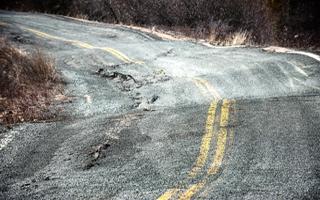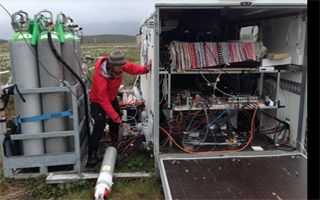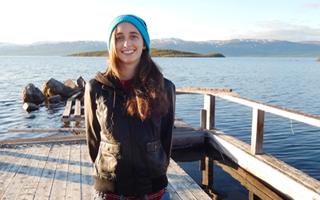Examples of CARPE Research Projects
Infrastructure and Mobility
Transportation in northern latitudes relies on stable permafrost and winter freezing, which allow travel on roads, over frozen snow-covered land, lakes, rivers, and coastal waters. Changes in Arctic temperatures and weather patterns are already causing affecting winter mobility due shorter freezing seasons, increased mid-winter freeze-thaw cycles, ephemeral snowpacks, and rain-on-snow event.
CARPE students will develop models to improve understanding of Arctic mobility in the face of changing freeze-thaw and winter snow conditions to better manage road networks and other transportation corridors. Because Arctic mobility, which includes dog sleds, snowmobiles, and walking, extends beyond the traditional road network, CARPE students will draw from Indigenous and other local perspectives to assess mobility impacts to hunting, tourism, and planned nomadic practices of Arctic communities. CARPE students will learn to rethink existing agency transportation performance metrics as they relate to changes in seasonality and be more inclusive of traditional knowledge mobility challenges and tipping points.
-
Jennifer Jacobs
-
Michael Palace
-
Liz Burakowski
-
Aurora Consortium partners including the Federal Highway Administration and the Long-Term Pavement Performance program
-
NNA Community Office

Pathogens and Toxins
Toxins and pathogens released from thawing soils and melting ice can move through the environment and ecosystems and potentially affect the health and well-being of Arctic residents. Such warming-induced increases in pathogens, pollutants, and toxins have the potential to endanger human and animal health and threaten food supplies.
CARPE students will investigate the toxicology and microbial ecology of environmental and animal samples in northern Sweden, including metagenomic analysis to elucidate fungi, bacteria, and viral DNA present in samples, microbial ecology investigations to target the evolution and antimicrobial resistance of pathogens, and analysis of heavy metals.
-
Julie Bryce
-
Jessica Ernakovich
-
Ruth Varner
-
Climate Impacts Research Center (Umeå Univ.)
-
Johanna Nilsson, Swedish Natural Society
-
Indigenous Sámi community partners
-
CRREL – Robyn Barbato

Permafrost Biogeochemistry and Food Security
Foraged foods, which are known as “country foods” in the Alaskan Arctic, are an essential source of dietary nutrients. Diets otherwise consist of external food sources delivered by plane or barge, which are expensive, place higher importance on shelf life than nutrient density, and threaten food security in Arctic communities. Berries (e.g., blueberries, crowberries, and cloudberries) are a crucial source of phytonutrients for Arctic people, offering affordable access to local nutrients. Changing seasonality has increased the variability in the timing and yield of berry harvests and may affect the nutrient profile of berries. Berry nutrition is just one of many examples of how biogeochemical asynchronies impact Arctic food systems.
CARPE trainees will investigate how changing seasonality impacts the nutritional quality of harvested berries, exploring topics such as how changes in growing season duration and soil nutrient availability impact both yields and phytochemistry. This will require collaboration between biogeochemists, plant physiologists, and Indigenous knowledge holders to understand historic patterns of the locations and timing of berry harvests, as well as changes in potential drivers that could lead to biogeochemical asynchronies of soil nutrients and plant nutrient uptake.
- Jessica Ernakovich
- Alix Contosta
- Liz Burakowski
- Ruth Varner
- Bonanza Creek LTER – Elena Sparrow and Katie Spellman
- NNA Community Office
- Winterberry citizen science project working with Local and Indigenous communities

Aquatic Ecosystems and Greenhouse Gas Exchange
Arctic aquatic ecosystems are important sources of methane, a strong greenhouse gas. Altered seasonality is driving earlier ice out and longer ice-free seasons, leading to earlier release of methane trapped under lake ice and in warmer lake sediments. Declining ice thickness and timing of ice-out impact tourism and winter sport and fishing activities as well as animal migration. Permafrost thaw is also causing “old” stored carbon to become available for decomposition. This carbon can be transformed by microbial communities into carbon dioxide, methane, or remain as dissolved inorganic or organic carbon as well as particulate organic forms. Understanding the impact of change in ice-free season (timing of onset and change in length) is critical for understanding climate feedbacks as well as the impact on humans in these regions.
CARPE trainees will converge the disciplines of hydrology, biogeochemistry, and remote sensing to pursue research topics. They will work with partners at 3 established research sites with long-term observations in northern Sweden, where PI Varner has established relationships with researchers over the last decade. Trainees will investigate glacier and snow melt dynamics at Tarfala, the impact of snowmelt on peatland and permafrost lakes at Stordalen Mire, and thermokarst lake formation and landscape change at Tavvavuoma. This transect represents the full range of naturally formed lake types in the Arctic, with the benefit of being essentially at a similar latitude and climate regime. All sites have also developed collaborations with local Sámi Indigenous communities, bringing opportunities for developing partnerships.
-
Ruth Varner
-
Michael Palace
-
Cameron Wake
-
Meghan Howey
-
Nina Kirchener and Britta Sannel, Stockholm University (SU)
-
Climate Impacts Research Centre (Umeå Univ.)
-
Johanna Nilsson, Swedish Natural Society
-
Indigenous Sámi community partners
